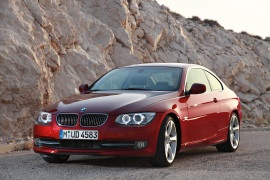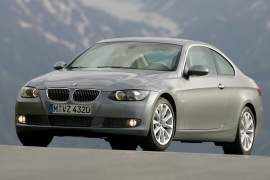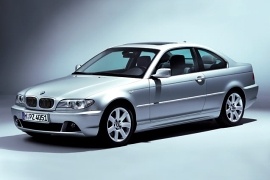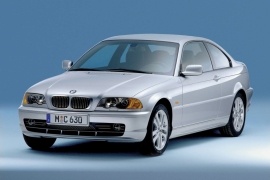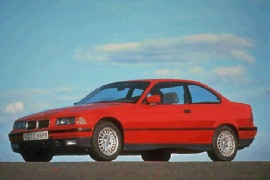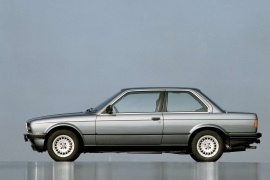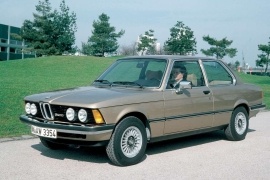BMW 3 Series Coupe Models/Series Timeline, Specifications & Photos
First production year: 1975
Engines: Gasoline, Diesel
Body style: Coupé (two-door)
Two years after the launch of the refreshed sedan and the station wagon versions of the 3 Series, BMW announced the introduction of the facelift for their coupe sibling, the E92.
Since the world financial crisis that started in 2008 had already begun to slow down. The first signs of economic relief had appeared, BMW dared to announce the facelift of the 3 Series Coupe, known as the E92, in factory coding. It happened just months after the release of the Toy Story 3 movie that topped the charts for the 2010 year, and the car was, at the same time, the third member of the 3 Series family. This car was a toy for many thanks to its look, performance, and comfort. However, the LCI, or Life Cycle Impulse as BMW preferred to name its facelifted models, came with significant upgrades in all areas, starting from the exterior and continuing to the interior technology package and, most importantly, its engine bay.
Right off the bat, the E92 had an appreciated design and far less polarizing customers than its sedan and station wagon siblings. As a result, it was challenging to refresh it without spoiling the car’s look. But still, BMW gambled and won. At the front was a new set of headlights with available bi-xenon brights and circular daytime running lights. Its turn signal lamps had LEDs, and the clear glass that covered the entire assembly made the vehicle look wider. Between them, the automaker installed a new grille with a chromed rim around it, featuring black or chromed vertical slats, depending on the grade and options. In addition, the lower bumper was new, featuring satin-silver horizontal fins on the side scoops. The automaker decided to create one singular broad air intake instead of a split-three one, like on the previous version, albeit that was offered as part of the M-Package.
From its profile, the low-slung bodywork emphasized the sporty character of the E92. It didn’t look like a shortened version of the sedan but as a completely different vehicle. Its long doors had no frames for the windows, and the 2009 model year came with new sets of alloy wheels ranging between 16- and 18-inches. At the back, the E92 LCI had the same L-shaped taillights as its predecessor but narrower reversing lights. Thanks to the wider rear track, the car looked even more muscular and ready for high-speed cornering.
Inside, the base versions came with the same low-mounted dashboard with the instrument cluster facing the driver. As an option, customers could get the E92 with a new 8.8-inch infotainment unit named iDrive. The new system showed a list-style menu instead of the grid-like one as before, and it could be controlled via a rotary knob placed on the center console. For this version of the bodywork, BMW chose to install high-bolstered seats at the front with an option for even more grippier sports seats. In the back, even though it wasn’t a car made for children, the automaker installed ISOFIX anchoring points for child seats.
But the most significant upgrade was found under the hood. There, the automaker dropped the lower-powered versions, and the base model came with a 143 PS (141 hp) turbodiesel, while the top-spec model was fitted with an inline-six turbocharged gasoline engine that produced 306 PS (302 hp). All the oomph was sent to the rear wheels or in all corners, depending on the options. Besides the standard six-speed manual gearbox, the E92 was also available with a six-speed automatic.
BMW 3 Series Coupe (E92) 318i 6MT RWD (143 HP)
BMW 3 Series Coupe (E92) 320i 6MT RWD (170 HP)
BMW 3 Series Coupe (E92) 325i 6MT RWD (218 HP)
BMW 3 Series Coupe (E92) 325i xDrive 6MT AWD (218 HP)
BMW 3 Series Coupe (E92) 330i 6AT RWD (272 HP)
BMW 3 Series Coupe (E92) 330i 6MT (272 HP)
BMW 3 Series Coupe (E92) 330i xDrive 6AT (272 HP)
BMW 3 Series Coupe (E92) 330i xDrive 6MT (272 HP)
BMW 3 Series Coupe (E92) 335i 6MT RWD (306 HP)
BMW 3 Series Coupe (E92) 335i xDrive 6MT (305 HP)
BMW 3 Series Coupe (E92) 320d 6AT RWD (184 HP)
BMW 3 Series Coupe (E92) 320d 6MT RWD (184 HP)
BMW 3 Series Coupe (E92) 320d xDrive 6AT AWD (184 HP)
BMW 3 Series Coupe (E92) 320d xDrive 6MT AWD (184 HP)
BMW 3 Series Coupe (E92) 325d 6MT RWD (204 HP)
BMW 3 Series Coupe (E92) 330d 6AT RWD (245 HP)
BMW 3 Series Coupe (E92) 330d 6MT RWD (245 HP)
BMW 3 Series Coupe (E92) 330d xDrive 6AT AWD (245 HP)
Released in July 2006, more than a year after the unveiling of its Sedan and Touring stablemates, the 3 Series Coupe E92 had a much sportier appearance and improved styling.
While Joji Nagashima penned the other two bodywork versions, Marc Michael Markefka designed the coupe version of the fifth generation of the 3 Series. The car relied on a new platform, the BMW L2, shared with the first generation of the 1 Series. The E92 (factory internal coding) was a genuine sports-oriented coupe thanks to the long wheelbase and the revised suspension. It also had a new shape with a low-slung profile, making it look fast even when standing still. As a result, the E92 was not as polarizing as its Sedan and Touring siblings, and the brand’s fans were satisfied with the look of the car. To sweeten the deal, BMW installed a choice of diesel and gasoline engines that could send their power to the rear axle or in all corners, depending on the version.
The E92’s had a lower nose than its two siblings, the Sedan and the Touring. As a result, its front fascia looked wider. It also sported new headlights, with a swept-back design but looking angrier. Between them, the automaker placed the flatter and wider elements of the kidney grille adorned by chromed surroundings. For the bumper, the designer followed the same ideas as the other versions of the car but with a broader lower air intake split into three parts, where the outer sections sported the fog lamps.
Thanks to the long hood, low-slung greenhouse, and the sloped rear window, the E92 didn’t look like a sedan anymore. In fact, it didn’t share any panels with its family-oriented stablemates. An ascending creased line started from the front fenders and continued on the sides over the long doors with frameless windows. It continued towards the back of the car, ending on the taillights. On the lower side of the bodywork, BMW also added new side sills that were profiled to reduce ground effect. Finally, at the back, the E92 sported L-shaped taillights extended from the quarter panels onto the trunk’s lid. Lower, the bumper sported one or two cuts, depending on the grade and options.
Inside, the automaker had to make some adjustments to provide customers a unique driving experience without even turning on the engine. Fronting the driver was a simple and rounded instrument cluster featuring large dials for the speedometer and tachometer, flanked by the fuel and temperature gauges. Like its sedan and station wagon versions siblings, the 3 Series Coupe was available with either a plain dashboard featuring an instrument cluster fronting the driver or a built-in display for the infotainment unit. Like the previous generations of the 3 Series, this also had the center stack tilted towards the driver. At the same time the center console housed the i-Drive controller (when fitted) and the ashtray. The buttons for the power windows were moved on the door cards. Finally, in the back, the automaker installed a bench seat for two, albeit with very limited headroom.
Under the hood, BMW installed a choice of diesel and gasoline engines with four or six cylinders and up to 306 PS (302 hp) paired with either six-speed manuals or six-speed automatic transmissions. Power went to the rear axle or in all corners, depending on the version. In addition, BMW offered a seven-speed automatic (dual clutch) gearbox for the 335i.
BMW 3 Series Coupe (E92) 320d 6AT RWD (177 HP)
BMW 3 Series Coupe (E92) 320d 6MT RWD (177 HP)
BMW 3 Series Coupe (E92) 320d xDrive 6AT AWD (177 HP)
BMW 3 Series Coupe (E92) 320d xDrive 6MT AWD (177 HP)
BMW 3 Series Coupe (E92) 330d 6AT RWD (231 HP)
BMW 3 Series Coupe (E92) 330d 6MT RWD (231 HP)
BMW 3 Series Coupe (E92) 330xd 6AT RWD (231 HP)
BMW 3 Series Coupe (E92) 320i 6AT RWD (170 HP)
BMW 3 Series Coupe (E92) 320i 6MT RWD (170 HP)
BMW 3 Series Coupe (E92) 325i 6AT RWD (218 HP)
BMW 3 Series Coupe (E92) 325i 6MT RWD (218 HP)
BMW 3 Series Coupe (E92) 325xi 6AT RWD (218 HP)
BMW 3 Series Coupe (E92) 325xi 6MT RWD (218 HP)
BMW 3 Series Coupe (E92) 328i 6AT RWD (230 HP)
BMW 3 Series Coupe (E92) 328i 6MT RWD (230 HP)
BMW 3 Series Coupe (E92) 328i xDrive 6AT AWD (230 HP)
BMW 3 Series Coupe (E92) 328i xDrive 6MT AWD (230 HP)
BMW 3 Series Coupe (E92) 330i 6AT RWD (272 HP)
BMW 3 Series Coupe (E92) 330i 6MT RWD (272 HP)
BMW 3 Series Coupe (E92) 330xi 6AT RWD (272 HP)
BMW 3 Series Coupe (E92) 330xi 6MT RWD (272 HP)
BMW 3 Series Coupe (E92) 335i 6AT RWD (306 HP)
BMW 3 Series Coupe (E92) 335i 6MT RWD (306 HP)
BMW 3 Series Coupe (E92) 335i 7AT RWD (306 HP)
Five years after the introduction of the BMW E46 3 Series Coupe, the German automaker unveiled the refreshed version of the car, an update named by BMW as the LCI, or Life Cycle Impulse.
BMW's styling department, led by Chris Bangle, managed to create a timeless design for the E46 Coupe. As a result, it was challenging to upgrade the car's look without spoiling it. As a result, the best it could do was to slightly update the front fascia and the taillights and add new bumpers and new options for the alloy wheels. The automaker also introduced new interior features, including XM Sirius Satellite radio for specific markets and navigation, which led to a redesigned center stack. Under the hood, there were also significant upgrades. BMW had to upgrade its engines to keep up with the competition, and it proved once again that sometimes larger engines were more fuel-efficient than low-displacement ones.
Up front, the 2003 BMW 3 Series Coupe had reshaped headlights with an option for HID bulbs. They flanked the classic BMW kidney grille, which was integrated into the front side of the hood. Lower, the wrapped-around plastic bumper featured a new lower apron that sported a broad center air intake flanked by a pair of triangular scoops with available fog lamps. The automaker also provided the option for an M-Package, which added a more aggressive-looking bumper with a design inspired by the M3.
The low-slung profile of the coupe was classic, featuring a long nose with a flat hood and a raked windshield followed by a short roof. Thanks to its sloped-down rear window and the short trunk, the car looked like it was leaning forward. The body-colored door handles and redesigned side sills also made the car look premium, which it was. Out back, BMW installed new corner-mounted LED taillights, which were extended on the trunk's lid. Lower, the wrapped-around plastic bumper featured a black area miming a diffuser. Depending on the engine, the 3 Series coupe had one or twin pipes on a side.
Customers could get inside the vehicle via the frameless doors, which windows rolled down automatically when opened and up when they were closed. This feature ensured better insulation against wind. The cabin was fitted with a pair of bolstered seats at the front with an option for sportier ones that featured an expandable cushion that supported the legs even better. BMW offered the car with fabric or leather upholstery. Fronting the driver was a refreshed instrument cluster that could be adorned by silver encirclements for the dials. The automaker kept the fuel-efficiency meter on the lower side of the tachometer. Underneath all dials, the instrument panel featured an LCD that showed data gathered from the car's onboard computer. On the center stack, customers had the option of a standard audio system. At the same time, a sat-nav unit was available at extra cost. In the back, the bench seat was cramped, but it could still provide enough room for two adults, albeit for short jaunts.
Under the hood, the 2003 BMW 3 Series Coupe offered a choice of diesel and gasoline engines, with four or six cylinders. Only the oil burners were turbocharged, while the spark-ignited ones were naturally aspirated. Power went to the rear wheels only, unlike the sedan or the station wagon, which were also fitted with AWD versions.
BMW 3 Series Coupe (E46) 318Ci 5AT RWD (143 HP)
BMW 3 Series Coupe (E46) 318Ci 5MT RWD (143 HP)
BMW 3 Series Coupe (E46) 320Ci 5AT RWD (170 HP)
BMW 3 Series Coupe (E46) 320Ci 5MT RWD (170 HP)
BMW 3 Series Coupe (E46) 325Ci 5AT RWD (192 HP)
BMW 3 Series Coupe (E46) 325Ci 5MT RWD (192 HP)
Like on the third generation of the 3 Series, the E36, BMW kept its customers waiting on their toes before launching the coupe version of the fourth generation of this nameplate, which it unveiled in late 1998.
The introduction of the E46, which was the car’s factory codename, in November 1997 for the 1998 model year quickly made the brand’s fans ask BMW when it would unveil the coupe. The answer came a year later, in December 1998, for the 1999 model year. Like in the previous generation, the automaker didn’t just cut two doors and made the front ones longer and called it a day. Besides the aesthetic look, the new version had significant upgrades in the suspension department and interior. Furthermore, this version was available with turbodiesel engines and all-wheel drive for the first time in the model's history. Nevertheless, the AWD versions, known as xDrive in the carmaker’s language, became very popular among those who didn’t want a Bimmer due to its rear-wheel drive platform.
Unlike the sedan, which was penned by Chris Bangle and Wolfgang Reitzle, the coupe was the creation of Erik Goplen. He took the front fascia of the sedan and then squashed it a little to make it look narrower, but it had to use the same headlights to cut production costs. Like its four-door brother, it sported the famous BMW kidney grille integrated into the front side of the hood, not as a separate part. Lower, on the bumper, the 3 Series coupe had a new styling for the apron, sporting a broader air intake and with an available M-look packet that made it look aggressive.
While the sedan was the darling of the families, the coupe addressed customers who didn’t need rear seats, and the look mattered a lot to them. As a result, the low-slung coupe featured a long hood followed by a raked windshield tilted even more than on the sedan. In addition, the lower roof was short and curved and ended in a sloped-down rear window. The automaker installed a short, flat rear deck in the back. As a result, the car’s profile looked dynamic even when standing still. Those who opted for higher grades received the 3 Series coupe with 16-inch alloy wheels, while the base versions were available with 15-inch ones.
Inside, the driver-oriented dashboard was a known BMW design theme, although, on the E46, the center stack was integrated even better than in the previous generation of the car. However, the layout concept was still preserved, with the stereo mounted on the upper area and the HVAC buttons placed lower. Unlike its predecessor, the 3 Series coupe didn’t have the onboard computer display placed there but integrated into the instrument panel. Starting with the E46 coupe, BMW introduced a new standard feature for this bodywork version. The seatbelts featured an automatic mechanism integrated into the B-post that “served” the front occupants with these safety devices when they sat in the car. Thanks to the longer wheelbase, compared to the E36, there was enough legroom in the back on the bench seat and even enough headroom for adult-sized passengers.
Under the hood, BMW installed a wide choice of diesel and gasoline engines with four or six cylinders. These were paired with five- or six-speed manual transmission, while a five-speed automatic was on the options list. Besides the x-labeled versions, which featured an all-wheel drive system, all the others were rear-wheel drive.
BMW 3 Series Coupe (E46) 318Ci 4AT RWD (118 HP)
BMW 3 Series Coupe (E46) 318Ci 5AT RWD (143 HP)
BMW 3 Series Coupe (E46) 318Ci 5MT RWD (118 HP)
BMW 3 Series Coupe (E46) 318Ci 5MT RWD (143 HP)
BMW 3 Series Coupe (E46) 320Ci 5AT RWD (150 HP)
BMW 3 Series Coupe (E46) 320Ci 5AT RWD (170 HP)
BMW 3 Series Coupe (E46) 320Ci 5MT RWD (150 HP)
BMW 3 Series Coupe (E46) 320Ci 5MT RWD (170 HP)
BMW 3 Series Coupe (E46) 323Ci 5AT RWD (170 HP)
BMW 3 Series Coupe (E46) 323Ci 5MT RWD (170 HP)
BMW 3 Series Coupe (E46) 325Ci 5AT RWD (192 HP)
BMW 3 Series Coupe (E46) 325Ci 5MT RWD (192 HP)
BMW 3 Series Coupe (E46) 328Ci 5AT RWD (193 HP)
BMW 3 Series Coupe (E46) 328Ci 5MT RWD (193 HP)
BMW didn’t rush the coupe of the third generation of the 3 Series into production and waited until it was sure that the sporty vehicle would dominate the segment.
Right after the unveiling of the E36 sedan, the carmaker’s fans waited for the coupe version. BMW promised them that it would not be just a two-door version of the four-door sedan, like the E30, but something better, and the automaker kept its word. While it shared many parts with its sedan stablemate, it was different in many ways. Even though it had the same platform and wheelbase as its family-oriented sports sedan, it had a stiffer suspension, better weight distribution, and even a new styling. Still, many parts were carried over to reduce production costs, but that didn’t bother anyone who wanted to drive an upscale, sporty-looking coupe that could move the way it looked.
At the front, the car featured rectangular headlights that protected the high and low beams under the same piece of glass. Its turn signals, even though they were separate parts, they looked like they were integrated into the headlights. Between them, the 1992 BMW 3 Series Coupe (E36) had the classic kidney grille, although it was wider and reimagined with a fresh look. Below, the automaker installed a wrapped-around plastic bumper that featured a center air intake in the middle flanked by the available fog lamps. These were standard for the higher-powered versions.
From the side, the raked windshield was tilted even more than on the sedan, and the greenhouse had a lower roof. As expected from a coupe, the doors were longer than on the sedan, and unlike them, they didn’t have a window frame. Behind them, the glass area for the rear-seated passengers featured a pop-out system that allowed for quick opening to refresh the cabin’s interior. Behind the rear sloped-down window, the automaker installed a short deck, emphasizing the car's sporty look. Out back, the corner-mounted taillights were extended on the trunk lid, thus making the vehicle look wider, while at the lower side, the bumper had a body-colored apron ending with a black trim.
Inside, the dashboard was carried over from the sedan and had a center stack wider than on the E30 3 Series. It was neatly integrated into the overall design and looked like an extension of the instrument cluster. There, the automaker placed the stereo in an upper position for convenient access and offered a ten-speaker cassette player and a CD changer with ten discs, while lower was the HVAC. On the center console, the automaker placed the gear stick, or the gear selector for the automatic transmission versions, and the buttons for the power windows. BMW installed manual bucket seats with high-bolstered areas for the front passengers. They had several adjustments, including on height, which was sometimes useless since the roof was very low. In the back, the split-folding (50/50) bench seat could accommodate two passengers, although legroom and headroom were limited.
Under the hood, the 1992 BMW 3 Series Coupe (E36) came with a choice of gasoline and diesel engines, ranging between 102 PS (101 hp) and 193 PS (190 hp), depending on the market. All versions sent their torque to the rear wheels via a row-your-own-gears five-speed manual or a GM-sourced four-speed automatic. Surprisingly, BMW didn’t provide an all-wheel drive version for the E36, a feat that was available in the previous generation of the 3 series.
BMW 3 Series Coupe (E36) 316i 4AT RWD (102 HP)
BMW 3 Series Coupe (E36) 316i 5MT RWD (102 HP)
BMW 3 Series Coupe (E36) 318iS 4AT RWD (140 HP)
BMW 3 Series Coupe (E36) 318iS 5MT RWD (140 HP)
BMW 3 Series Coupe (E36) 320i 5AT RWD (150 HP)
BMW 3 Series Coupe (E36) 320i 5MT RWD (150 HP)
BMW 3 Series Coupe (E36) 325i 5AT RWD (192 HP)
BMW 3 Series Coupe (E36) 325i 5MT RWD (192 HP)
After seven years on the market and a successful career, the first generation of the 3 Series, the E21, was replaced by one of the most famous cars in BMW’s history, the E30 3 Series.
The introduction of the second generation of the 3 Series was no surprise for the automaker’s customers. They had expected it since the previous model, the E21 generation, reached its seventh year on the market, and BMW didn’t disappoint them. As a result, the E30 was unveiled in late 1982 for the 1983 model year. It instantly became the benchmark for compact executive sport sedans, and it was available in two flavors, coupe and four-door. The two-door version targeted younger customers or at least those who didn’t need to put anyone in the rear seats. BMW developed an utterly new platform for it and took just some modified M10 engines from the previous generation. Furthermore, if the five-speed manual was available only on specific E21 versions, it became standard across the range on the E30, and it even included some delightful amenities, such as a power moonroof, windows, and locks.
With a design signed by one of the most influential figures in post-war European car styling, Claus Luthe, the E30 charmed its buyers. Its front fascia adopted a similar styling as the E21, albeit just the one with twin headlights, which made it look miles ahead of other competitors. The simple design language of the vehicle, with horizontal lines on the grille interrupted in the middle by BMW’s kidney grille, made the 1983 3 Series instantly recognizable from the front. It still had the chromed bumper adorned on the ends by plastic covers, but it also had an apron underneath to lower the ground effect and improve aerodynamics.
From its profile, the new 14-inch alloy wheels had a unique design resembling a multi-blade turbine. Unlike its predecessor, the E30 coupe had a slightly ascending waistline emphasized by the already-known Hofmeister-kink design theme on the C-posts. Furthermore, it featured a short, straight rear deck, not a sloped-down one like its predecessor. The second generation of the 3 Series coupe had the same wheelbase as its four-door sibling, and the automaker created longer doors to ease rear passengers’ ingress and egress into the car.
Inside, the automaker started to show its upscale-oriented profile. While the lower grades came with fabric-covered mild bolstered seats, customers could choose leather-wrapped interior and sports seats. These were also height-adjustable, a feat that not too many automakers offered in the compact-sedan segment. Fronting the driver was an instrument cluster that was filled with anything a driver needed, including large dials for the speedometer and tachometer and smaller gauges for the fuel level and coolant temperature. In addition, a fuel consumption meter was included below the rev counter.
But BMW thought about adding more options to the vehicle and installed an early version of what was known, later on, as an onboard computer. That provided valuable data, such as the service interval (with green, yellow, and red LEDs) underneath the dials. At the same time, another computer with push buttons showed potential problems via red LEDs and also featured an LCD that revealed data about average speed, fuel efficiency, or driving times. The latter unit was placed on the center stack and tilted towards the driver. Between the front occupants, the narrow center console housed the gear stick or the gear selector (for automatic transmissions), depending on the grade and options. In the back, there was more legroom and headroom compared to the E21 generation.
Under the hood, BMW installed a wide choice of engines for the 1983 3 Series, with four or six cylinders. In addition, the automaker also provided the option for two diesel powerplants, turbocharged and naturally aspirated. Power went to the rear wheels via a five-speed manual or a three-speed automatic. The automaker introduced a facelift in 1986, which added significant improvements in all areas.
BMW 3 Series Coupe (E30) 316 4AT RWD (90 HP)
BMW 3 Series Coupe (E30) 316 5MT RWD (90 HP)
BMW 3 Series Coupe (E30) 316i 4AT RWD (102 HP)
BMW 3 Series Coupe (E30) 316i 5MT RWD (102 HP)
BMW 3 Series Coupe (E30) 318i 4AT RWD (105 HP)
BMW 3 Series Coupe (E30) 318i 4AT RWD (113 HP)
BMW 3 Series Coupe (E30) 318i 5MT RWD (105 HP)
BMW 3 Series Coupe (E30) 318i 5MT RWD (113 HP)
BMW 3 Series Coupe (E30) 318iS 5MT RWD (136 HP)
BMW 3 Series Coupe (E30) 320i 4AT RWD (125 HP)
BMW 3 Series Coupe (E30) 320i 4AT RWD (129 HP)
BMW 3 Series Coupe (E30) 320i 5MT RWD (125 HP)
BMW 3 Series Coupe (E30) 320i 5MT RWD (129 HP)
BMW 3 Series Coupe (E30) 323i 4AT RWD (150 HP)
BMW 3 Series Coupe (E30) 323i 5MT RWD (150 HP)
BMW 3 Series Coupe (E30) 325e 4AT RWD (129 HP)
BMW 3 Series Coupe (E30) 325e 5MT RWD (129 HP)
BMW 3 Series Coupe (E30) 325i 4AT RWD (170 HP)
BMW 3 Series Coupe (E30) 325i 5MT RWD (170 HP)
BMW introduced the first generation of the 3 Series, the E21, in 1975 as a replacement for the aging, nine-year-old 02 Series, and created the foundation for the one of the most important pillars in the carmaker’s history.
In 1962, the German automaker launched the “Neue Klasse Concept,” which led to the development of the 1602 lineup in BMW’s inventory. The idea of a small-sized, two-door, lightweight vehicle that could provide a sporty feeling for the driver and enough room for a family took off. The results were excellent, and the model was sold in almost 900,000 copies between 1966 and 1977. For the European market, though, BMW considered that the car had to be replaced after nine years into production. As a result, research for the car’s successor began in the early ‘70s, and the final product was unveiled in the summer of 1975 at the Munich Olympic Stadium. Furthermore, along with this lineup, the car manufacturer changed the naming system, where the first number represented the family model and the other two the engine’s displacement. This tradition continued for decades, with just a few exceptions.
The appearance of the new 3 Series, known as the E21 in factory coding, was a step above the 1600, but not that much so customers wouldn’t recognize it. While at first sight, it looked like an evolution, it was, in fact, a revolution. At the front, the car had the same two-headlights design as its predecessor, and between them was a broad black grille with horizontal slats. Later, the inline-six engine versions received a double-headlights design. In the middle, in a vertical position, BMW installed its famous “kidney grille” design theme. Below, the E21 featured a chromed metallic bumper with rubber endings, while on the lower side of the front fascia was an apron.
From its profile, the shark-nose design created an aggressive look for the vehicle. Thanks to the longitudinally-mounted engine, the automaker could make a low engine bay. The greenhouse wasn’t tall and featured a raked windshield followed by a short roof. In the back, the sedan-type rear window continued with a slightly sloped-down trunk lid. In the back, the car featured horizontal taillights and, depending on the version, had a plastic panel that adorned it or not. Below the chromed metallic bumper, the automaker installed either a single or dual exhaust system, depending on the version. BMW offered the 3 Series (E21) exclusively with two doors.
Inside, customers found a black, vinyl-covered dashboard with a short center stack tilted towards the driver. The same material also adorned the door cards, while the seats were cloth-upholstered. Fronting the driver was a clean-looking instrument panel filled with a speedometer, a tachometer, a fuel level gauge, and a coolant temperature indicator, along with other warning lights. On the center stack, the E21 had the controls for the HVAC system, while a stereo was on the options list. The front seats were slim but supportive and were fit even for taller people. At the same time, in the back, the bench seat could accommodate up to three occupants, although legroom was nothing to write home about.
In the beginning, the 3 Series was available exclusively with 1.6-, 1.8-, and two-liter inline-four engines. Later, in 1977, the automaker introduced the six-cylinder powerplants with either 2.0- or 2.3-liter, the latter being offered exclusively with a Bosch L-Jetronic fuel-injection system. Power went to the rear wheels via a four- or five-speed manual, depending on the version and options. Furthermore, a three-speed automatic was also available for specific models.
BMW 3 Series Coupe (E21) 315 4MT RWD (75 HP)
BMW 3 Series Coupe (E21) 316 4MT RWD (90 HP)
BMW 3 Series Coupe (E21) 318 3AT RWD (98 HP)
BMW 3 Series Coupe (E21) 318 4MT RWD (98 HP)
BMW 3 Series Coupe (E21) 318i 3AT RWD (105 HP)
BMW 3 Series Coupe (E21) 318i 4MT RWD (105 HP)
BMW 3 Series Coupe (E21) 320 3AT RWD (122 HP)
BMW 3 Series Coupe (E21) 320 4MT RWD (122 HP)
BMW 3 Series Coupe (E21) 320i 3AT RWD (125 HP)
BMW 3 Series Coupe (E21) 320i 4MT RWD (125 HP)
